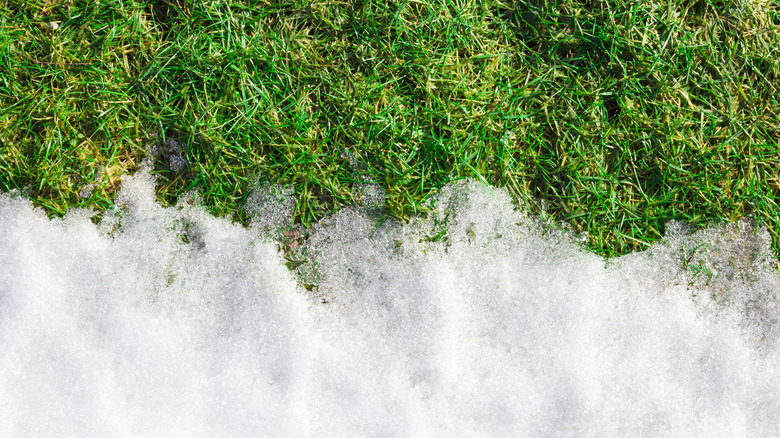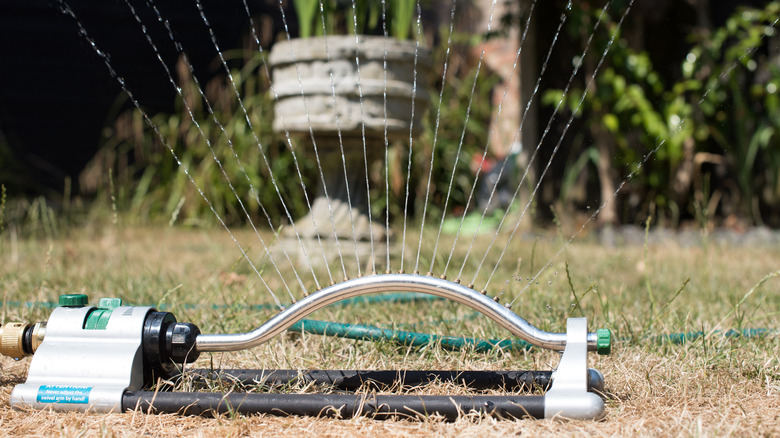We all know that once spring arrives, there’s quite a bit to do to get the lawn looking its best. That likely means spending time raking out the grass to loosen up matted areas, fertilizing to add nutrients, and even aerating the lawn to get more oxygen heading deep into the root system to encourage summer green. That’s only what needs to happen in spring, though. What you may not realize is that there are steps you can take during the coldest months to ensure your lawn is in the best possible condition come springtime, and these go beyond basic winter preparation.
In an exclusive interview with House Digest, Scot Masterson, the founder of Brookfield Lawn Care, offers tips for winter lawn care that anyone can apply. “If you live in one of the colder parts of the U.S., then it probably means that your lawn goes dormant during winter. This can be hard for those who love to keep their yards looking lush and vibrant all year-round — but have no fear!” he encourages. “Here’s how you can maintain a healthy and beautiful lawn even through winter so it’s lush in spring.”
Stay off the lawn and keep it clean

On a cold day, just a few steps on the lawn may create a snap and crackle as the blades of the grass bend and break, and while it sounds beautiful, it’s not a good thing. Even sending the dogs out in conditions like this can mean trouble for your lawn. “As tempting as it may be to trot out on a crisp winter’s day, try to refrain from stepping onto your grass during this period — chances are it’s too brittle and delicate underfoot,” advises Masterson. “Of course, if you need to head outside for some reason, just make sure you don’t walk too heavily over your lawn.”
Caring for your lawn during the winter starts by giving it a strong foundation as the temperatures begin to drop. To do that, it’s important to minimize problems that could damage the grass. Masterson brings attention to the ever-popular inflatables we love to display for the holidays. “Those charming holiday decorations may be eye-catching, but they can do damage to your lawn if not taken care of properly in the colder months,” he notes. “Make sure to take down any décor or equipment from your yard, as well as remove any dead leaves or debris that could block sunlight or air circulation.” Throughout the winter months, pay close attention to any buildup of materials on the surface, removing them as they accumulate to reduce risks.
Add mulch and keep salt away

Many people let snow pile on their grass without a second thought, hoping the lawn will be bright green when the spring melt arrives. Yet, it’s possible to create a protective barrier that could protect your lawn. “While mulch has many benefits for garden beds, adding a layer of it in late fall or early winter around trees and shrubs provides insulation against extreme temperatures and keeps them from drying out as well. Plus, it adds nutrition back into the soil,” says Masterson.
Salt is commonly used to melt snow and ice during the winter, but the substance is more worrisome to grass health than many recognize. Masterson says, “To prevent any salt damage come springtime (which can be devastating), make sure that none of this deicing substance gets within close proximity of your grass. Even when salt is used on pathways and sidewalks near the lawn, spraying water onto its surface afterward helps avoid any potential harm being caused by runoff.” Of course, if you do so, also stay conscious of the area re-freezing. Other alternatives include purchasing environmentally friendly ice melting products or trying to avoid using them at all to prevent the work of rebuilding the grass next season.
Mowing and watering

John Keeble/Getty Images
With spring’s arrival often comes pulling out the sprinkler to provide all the moisture the grass needs to grow and flourish, but Masterson reveals that it may not be beneficial if you start too early. “Up here in the north, most grass goes dormant in the cold winter weather,” he says. “So, you don’t want to overwater your lawn in this period as it won’t be able to absorb anything during the short, cold days. That said, if you are in a particularly dry winter season, then watering your grass on occasion while it’s dormant can help [ensure it will be] healthy come springtime.” It may also be advantageous to check moisture levels when there’s a break in the cold weather for an unseasonably warm few days. Take a rake to the surface to see how dry it is deeper down.
Should you mow throughout the winter months? Masterson says not to worry about it. “Once growth has stopped completely (usually by mid-December), pack away that mower until spring rolls around again — this helps ensure maximum dormancy protection for your grass. Plus, it gives you more time off from manual labor during these chillier months.” On the other hand, winter could be a great time to do lawnmower maintenance like sharpening the blades so it’s ready to go when the grass starts to grow again.




